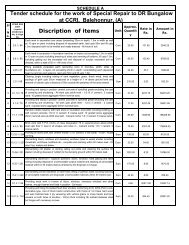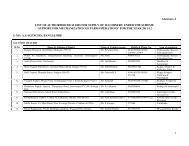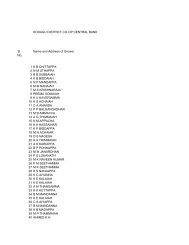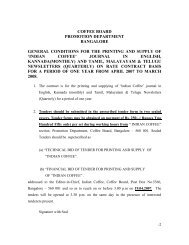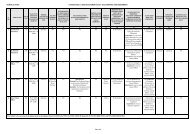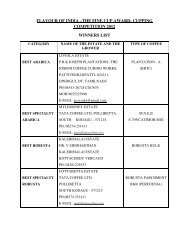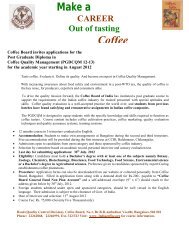COFFEE CULTIVATION GUIDE - Coffee Board of India
COFFEE CULTIVATION GUIDE - Coffee Board of India
COFFEE CULTIVATION GUIDE - Coffee Board of India
You also want an ePaper? Increase the reach of your titles
YUMPU automatically turns print PDFs into web optimized ePapers that Google loves.
• The effluent coming out <strong>of</strong> the aerobic lagoon be then stabilized in another<br />
tank for one day and used for irrigation if the BOD level is around 100 ppm.<br />
Preparation <strong>of</strong> cherry c<strong>of</strong>fee is one <strong>of</strong> the ways <strong>of</strong> avoiding water pollution. The<br />
cherry c<strong>of</strong>fee prepared from mature fruits which are carefully picked and sorted<br />
has better quality. Preparations <strong>of</strong> pulped natural c<strong>of</strong>fee (as in Brazil) also<br />
contribute towards avoiding the production <strong>of</strong> c<strong>of</strong>fee effluent.<br />
5. <strong>C<strong>of</strong>fee</strong> Berry Borer Management<br />
The recommended phyto-sanitary methods have to be cleanly followed in the<br />
estate adopting cultural and mechanical operations.<br />
• Broca traps have to be installed in the estate as well as near the drying<br />
yards<br />
• Picking mats should be used during the harvesting. Use <strong>of</strong> picking mats<br />
facilitates the easy collection <strong>of</strong> fallen berries and avoids the berries<br />
coming into contact with the soils thereby preventing the possible mould<br />
formation.<br />
• All the left over berries on the plants and gleanings should be cleanly<br />
picked<br />
• If the berries are partially damaged by <strong>C<strong>of</strong>fee</strong> Berry Borer, such berries<br />
can be immersed in boiling water for 1 minute and then dried.<br />
• Highly damaged berries should be destroyed by burning<br />
• <strong>C<strong>of</strong>fee</strong> should be dried to the recommended moisture level.<br />
• Care should be taken not to transport c<strong>of</strong>fee from the CBB infested area to<br />
the non-infested areas.<br />
• While procuring gunny bags from the c<strong>of</strong>fee curing works, they should be<br />
properly fumigated to avoid the entry <strong>of</strong> CBB into your estate. The<br />
growers shall demand fumigation <strong>of</strong> gunny bags by the c<strong>of</strong>fee curers.<br />
Always use clean and as far as possible new gunny bags.<br />
6. Dadap protection<br />
Protect the young dadap plants (during the first 2 years after planting) from<br />
scorching sun by treating (brushing or spraying) the stems with 10% lime solution<br />
(10.0 Kgs <strong>of</strong> spray lime in 100 litres <strong>of</strong> water).<br />
7. Watering young c<strong>of</strong>fee plants<br />
44<br />
After the monsoon, it is recommended that young c<strong>of</strong>fee plants should be<br />
watered with 5 to 10 litres water per plant once in a week. This avoids the wilting<br />
and death <strong>of</strong> young plants and facilitates easy and faster rooting <strong>of</strong> the plants. The<br />
growth <strong>of</strong> watered plants will be better and plants grow healthily. When the<br />
moisture content <strong>of</strong> the soil comes down in watered plants area, again the plants<br />
need to be watered so that wilting <strong>of</strong> the plants can be prevented. It should be<br />
noted that weed germination is faster in the watered region and regularly they<br />
should be slash weeded. Water requirement is generally higher (evaporation rate is<br />
44



